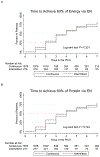Intermittent versus continuous enteral nutrition in critically ill children: A pre-planned secondary analysis of an international prospective cohort study
- PMID: 36306567
- PMCID: PMC9722589
- DOI: 10.1016/j.clnu.2022.09.018
Intermittent versus continuous enteral nutrition in critically ill children: A pre-planned secondary analysis of an international prospective cohort study
Abstract
Background & aims: Intermittent enteral nutrition (EN) may have physiologic benefits over continuous feeding in critical illness. We aimed to compare nutrition and infection outcomes in critically ill children receiving intermittent or continuous EN.
Methods: International, multi-center prospective observational study of mechanically ventilated children, 1 month to 18 years of age, receiving EN. Percent energy or protein adequacy (energy or protein delivered/prescribed × 100) and acquired infection rates were compared between intermittent and continuous EN groups using adjusted-multivariable and 4:1 propensity-score matched (PSM) analyses. Sensitivity analyses were performed after excluding patients who crossed over between intermittent and continuous EN.
Results: 1375 eligible patients from 66 PICUs were included. Patients receiving continuous EN (N = 1093) had a higher prevalence of respiratory illness and obesity, and lower prevalence of neurologic illness and underweight status on admission, compared to those on intermittent EN (N = 282). Percent energy or protein adequacy, proportion of patients who achieved 60% of energy or protein adequacy in the first 7 days of admission, and rates of acquired infection were not different between the 2 groups in adjusted-multivariable and propensity score matching analyses (P > 0.05).
Conclusion: Intermittent versus continuous EN strategy is not associated with differences in energy or protein adequacy, or acquired infections, in mechanically ventilated, critically ill children. Until further evidence is available, an individualized feeding strategy rather than a universal approach may be appropriate.
Keywords: Continuous; Enteral nutrition; Intermittent; Outcomes; Pediatric intensive care unit.
Copyright © 2022 Elsevier Ltd and European Society for Clinical Nutrition and Metabolism. All rights reserved.
Conflict of interest statement
Conflicts of interest Authors have no conflict of interest or disclosure to report in relation to the submitted research work.
Figures

Similar articles
-
Nutritional practices and their relationship to clinical outcomes in critically ill children--an international multicenter cohort study*.Crit Care Med. 2012 Jul;40(7):2204-11. doi: 10.1097/CCM.0b013e31824e18a8. Crit Care Med. 2012. PMID: 22564954 Free PMC article.
-
Time to achieve delivery of nutrition targets is associated with clinical outcomes in critically ill children.Am J Clin Nutr. 2021 Nov 8;114(5):1859-1867. doi: 10.1093/ajcn/nqab244. Am J Clin Nutr. 2021. PMID: 34320161
-
Nutrition algorithms and bedside nutrient delivery practices in pediatric intensive care units: an international multicenter cohort study.Nutr Clin Pract. 2014 Jun;29(3):360-7. doi: 10.1177/0884533614530762. Epub 2014 Apr 16. Nutr Clin Pract. 2014. PMID: 24740498
-
Intermittent versus continuous feeding in critically ill adults.Curr Opin Clin Nutr Metab Care. 2018 Mar;21(2):116-120. doi: 10.1097/MCO.0000000000000447. Curr Opin Clin Nutr Metab Care. 2018. PMID: 29232262 Review.
-
Methods of Enteral Nutrition Administration in Critically Ill Patients: Continuous, Cyclic, Intermittent, and Bolus Feeding.Nutr Clin Pract. 2018 Dec;33(6):790-795. doi: 10.1002/ncp.10105. Epub 2018 Jun 20. Nutr Clin Pract. 2018. PMID: 29924423 Review.
Cited by
-
Chrononutrition in Critical Illness.Nutr Rev. 2025 Mar 1;83(3):e1146-e1157. doi: 10.1093/nutrit/nuae078. Nutr Rev. 2025. PMID: 38904422 Free PMC article. Review.
-
Continuous versus Intermittent Enteral Feeding in Critically Ill Children: A Systematic Review.Nutrients. 2023 Jan 6;15(2):288. doi: 10.3390/nu15020288. Nutrients. 2023. PMID: 36678158 Free PMC article.
-
The enteroendocrine axis and its effect on gastrointestinal function, nutrition, and inflammation.Curr Opin Crit Care. 2024 Aug 1;30(4):290-297. doi: 10.1097/MCC.0000000000001175. Epub 2024 Jun 13. Curr Opin Crit Care. 2024. PMID: 38872371 Free PMC article. Review.
-
An Assessment of Intermittent and Continuous Enteral Feeding in Critically Ill Children.Nutrients. 2025 Jan 15;17(2):301. doi: 10.3390/nu17020301. Nutrients. 2025. PMID: 39861429 Free PMC article.
-
Comparison of Protocol-Based Continuous and Intermittent Tube Feeding in Mechanically Ventilated Critically Ill Children - An Open Label Randomized Controlled Trial.Indian J Pediatr. 2024 Oct;91(10):1001-1007. doi: 10.1007/s12098-023-04941-x. Epub 2023 Dec 8. Indian J Pediatr. 2024. PMID: 38064124 Clinical Trial.
References
-
- Mehta NM, Skillman HE, Irving SY, Coss-Bu JA, Vermilyea S, Farrington EA, McKeever L, Hall AM, Goday PS, Braunschweig C. Guidelines for the Provision and Assessment of Nutrition Support Therapy in the Pediatric Critically Ill Patient: Society of Critical Care Medicine and American Society for Parenteral and Enteral Nutrition. JPEN J Parenter Enteral Nutr. 2017;41(5):706–42. - PubMed
-
- Mikhailov TA, Kuhn EM, Manzi J, Christensen M, Collins M, Brown AM, Dechert R, Scanlon MC, Wakeham MK, Goday PS. Early enteral nutrition is associated with lower mortality in critically ill children. JPEN J Parenter Enteral Nutr. 2014;38(4):459–66. - PubMed
-
- Bechard LJ, Staffa SJ, Zurakowski D, Mehta NM. Time to achieve delivery of nutrition targets is associated with clinical outcomes in critically ill children. The American journal of clinical nutrition. 2021;114(5):1859–67. - PubMed
-
- Tume LN, Eveleens RD, Verbruggen S, Harrison G, Latour JM, Valla FV, Espnic Metabolism E, Nutrition s. Barriers to Delivery of Enteral Nutrition in Pediatric Intensive Care: A World Survey. Pediatric critical care medicine : a journal of the Society of Critical Care Medicine and the World Federation of Pediatric Intensive and Critical Care Societies. 2020;21(9):e661–e71. - PubMed
-
- Eveleens RD, Hulst JM, de Koning BAE, van Brakel J, Rizopoulos D, Garcia Guerra G, Vanhorebeek I, Van den Berghe G, Joosten KFM, Verbruggen S. Achieving enteral nutrition during the acute phase in critically ill children: Associations with patient characteristics and clinical outcome. Clinical nutrition. 2021;40(4):1911–9. - PubMed
Publication types
MeSH terms
Grants and funding
LinkOut - more resources
Full Text Sources
Research Materials
Miscellaneous

